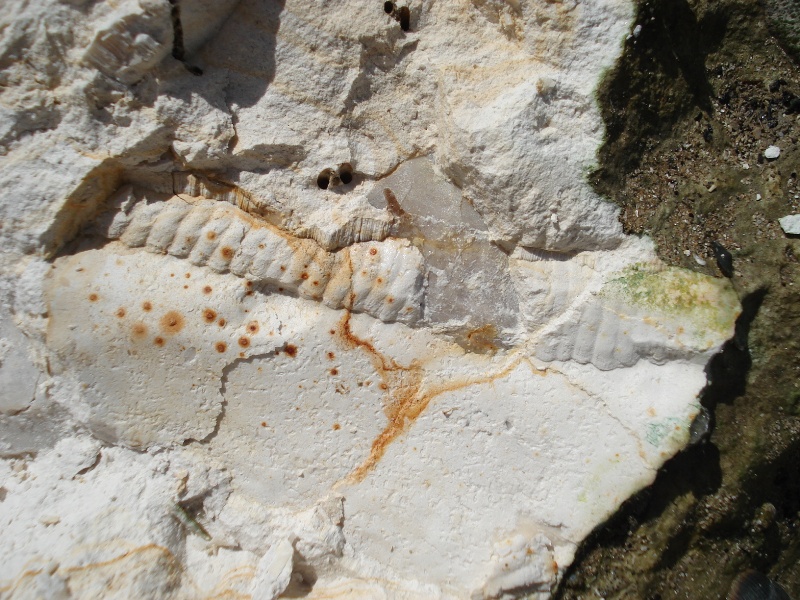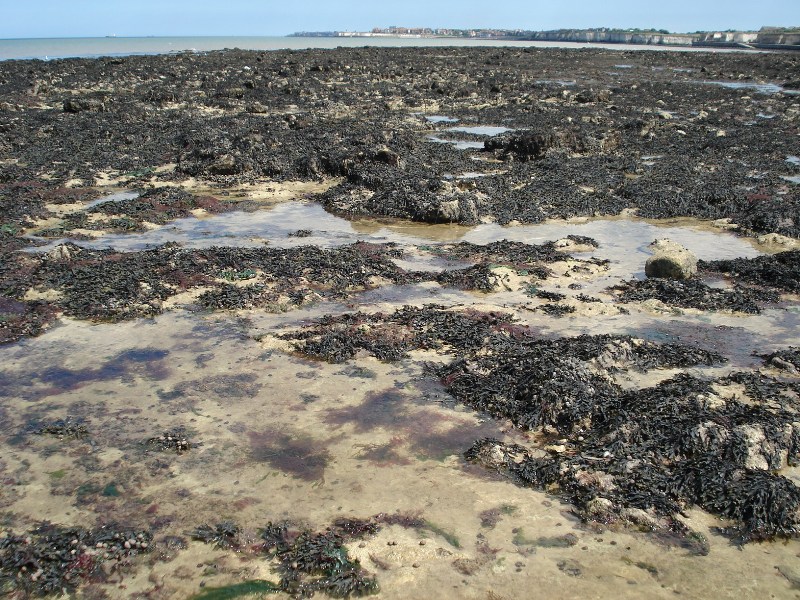Birchington is generally a poorly fossiliferous location. However, with patience, some specimens can be collected. Finds include Echinocorys, Micraster and Conulus echinoids (sea urchins), as well as bivalves, sponges and belemnites.
DIRECTIONS
♦ Park on Cliff Road at Birchington, next to one of the numerous places where the beach can be accessed. You can park right next to the beach and walk down a path through the low cliffs onto a promenade above the foreshore.
♦ From the promenade, find steps down to the foreshore onto the wave cut platform. Once on the foreshore, you can immediately start looking at any exposed chalk for fossils.
♦ Ref: 51.38299°N, 1.28904°E
PROFILE INFO
FIND FREQUENCY: ♦♦ – It can take quite a while to find anything in the wave cut platform at Birchington. Look out for the distinctive rings in the chalk, which are evidence of echinoids that have been eroded by the sea. If you are lucky, you may be able to find one only recently exposed and in good condition.
CHILDREN: ♦♦♦ – The foreshore is bisected by many small and larger gullies, so children should be supervised. The chalk can also be slippery when covered in weed.
ACCESS: ♦♦♦♦♦ – You can park right next to the beach and walk down a path through the low cliffs onto a promenade above the foreshore. From here, you can access the wave cut platform by means of steps.
TYPE: – The coast at Birchington consists of low cliffs that abut onto a promenade, below which is a chalk foreshore. Although the cliffs do contain fossils, they should be avoided and there is plenty of chalk to look at on the foreshore.
FOSSIL HUNTING
The most common fossil finds here are echinoids, of which Echinocorys seems to be most abundant, although you can also find other sea urchins such as Conulus and Micraster. Look over any areas of exposed chalk for fossils. Although not obvious, with time you should find something. What makes collecting difficult is the seaweed and algae. These tend to disappear during the winter months and return during the summer. Therefore, collecting is best out of season.

GEOLOGY
At Birchington, the White Chalk Subgroup (formerly Upper Chalk), from the Cretaceous epoch, is Santonian in age from the Margate Chalk Member. The Margate Chalk Member is part of the Newhaven Chalk Formation. This is marl-free, smooth white chalk, with little flint, and with iron-stained sponge beds, in which there are no formal subdivisions. The lower boundary is conformable immediately above the Barrois Sponge Bed at this location.


SAFETY
Common sense when collecting at all locations should always be used and you should check tide times before visiting. The weed and the gullies of the foreshore can make the going a little tough. Wellies are essential here. Make sure you collect on a retreating tide and ensure someone knows where you have gone and what time you expect to be back.
EQUIPMENT
A good, sturdy bag and plenty of packing material, as well as a hammer and chisel, are needed at this location. Waterproof boots with a good grip are essential.
ACCESS RIGHTS
This site is a site of special scientific interest (SSSI). This means you can visit the site, but hammering the bedrock is not permitted. For full information about the reasons for the status of the site and restrictions, download the PDF from Natural England.
It is important to follow our ‘Code of Conduct’ when collecting fossils or visiting any site. Please also read our ‘Terms and Conditions‘
LINKS
♦ Buy Fossils, Crystals, Tools
♦ Location Discussions
♦ Deposits Magazine
♦ Join Fossil Hunts
♦ UK Fossils Network














